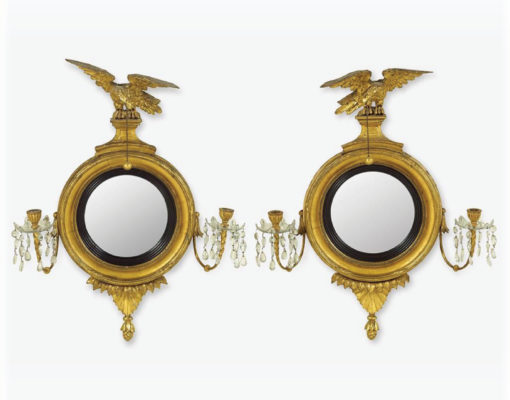The Renowned Collection
Pair of Girandoles
Henry Banks, London
Pair of girandoles, circa 1810
Mirrored glass, wood, gesso, gilding, blown and cut glass, metal
Gift of funds from Lila Acheson Wallace and others, by exchange
2018.1 a-g – 2 a-g
Convex mirrors, often enhanced with decorative crests and candle arms, were sought after furniture forms in English Regency and early American interiors.The technology to create convex mirrors first appeared during the Renaissance, when they symbolized scientific inquiry, omnipotence, as well as luxury.It was not until c. 1795 when English glass factories perfected the technology to produce large convex mirrors reliably enough to supply an international export market. Girandoles became an icon of English Regency taste, and perhaps even more desirable for well-to-do households in early 19th-century America. American craftsmen in New York and elsewhere also created girandoles (probably by fitting imported mirrors with their own frames), but English production dominated the market into the 1840s.
Wall-mounted mirrors during Boscobel’s period were not merely decorative, but served as lighting devices, reflecting daylight from an opposite or adjacent window. The French-derived term girandole refers to a wall mirror with attached candle arm(s). Their surface was designed to reflect daylight from windows and, when daylight was scarce but money was not, to reflect and magnify the luxury of candlelight. These girandoles illustrate the period’s dependence on daylight as well as its growing desire for artificial light. Candlesticks, argand lamps, and mirrors such as these girandoles were more than decorative; they were a means of controlling time. They extended the amount of time available for work, study, socializing, entertaining, and other indoor activities.
